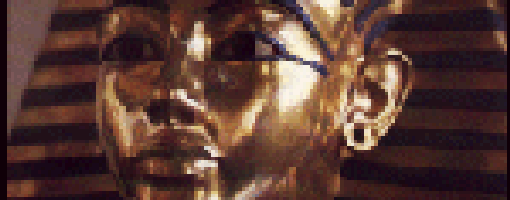Ancient Egyptian History, Pharaohs and Pyramids

Created: Apr 05, 2010,
modified: Jan 13, 2012,
overall rating: 1.000
The story of Cleopatra has become one of the classics of Western literature, retold many times in drama, opera, painting and film. Even though ours is the victor's view, Cleopatra stands out as one of the great figures of history. We forget that Octavian was for from certain of defeating her, and that initially Mark Anthony was the favoured successor of Julius Caesar. The history Cleopatra is difficult to find, so much has her legend come to dominate. Yet with her Egypt again shone brilliantly before being extinguished by 300 years of Roman rule.
The manner of Octavian's victory, and Egypt's importance as the 'granary of the empire', led to the country's unique position as a personal estate of the emperor. The ordinary people were reduced to a level little better than serfdom, and all privileges were in the hands of the Greek settlers and affluent Egyptians. Nevertheless, despite the country's dicline in importance, its influence in Rome was great. Egyptian religion, especially the worship of the goddess Isis, had spread throughout much of the Roman Empire even before the conquest of the country. Temples in honour of Isis and her associated gods were to be found in most major cities, and Egyptian priests officiated in her mysteries. Rome was adorned with monuments taken at the emperor's orders from the Egyptian temples. Egypt itself, especially the island of Philae. become a place of pilgrimage for the devotees if Isis. Sarapis, a god who was worshipped along with Isis, combined the Egyptian Osiris with Dionysos and Pluto. His vast temple at Alexandria housed the Library, the greatest storehouse of knowledge in the classical world. Such was its importance that it was the focus of Christian attacks in AD 391, when it, and its contents, were destroyed by fire.
Egypt's ancient monuments fascinated both the Greeks and the Romans, and they become tourist sites. Amongst the most celebrated was the singing statue at Thebes, one of the two Colossi of Memnon' Split by an earthquake in 27 BC, the northernmost of the two statues of Amenhotep 111(1386-1349 BC) gave out a strange musical note at dawn, a phenomenon possibly caused by the warming of the stone. The statue was believed to be of the Trojan hero, Momnon, who had been killed in battle by Achilles, and who was thought thus to greet his mother, the goddess Aurora, each morning. Graffiti and poems carved on the legs and feet of the statue record its many visitors. In the early third century, Septimius Severus had the crack repaired, rendering the image once again mute.
Few of the Roman emperors even set foot in Egypt, but one, Hadrian, did have a special devotion to the country. In AD 130, Hadrian, on a tour of the empire, arrived in Egypt. First spending two months in Alexandria. he and his entourage then sailed to Upper Egypt. However, half way to Thebes (Luxor), tragedy struck. On 30 October, Hadrian's favourite, Antinous, drowned in the Nail. Some sources say that Antinous drowned himself to thwart a prophecy which had foretold a calamity to the emperor.
Hadrian was disconsolate, and declared antinous a god. At the site of the drowning, Hadrian founded a city, Antinoe, whose ruined column-lined streets and classical theatre still stood when Napoleon's scholars visited it. Today, mountains of rubble and broken pottery are all that mark the place. Hadrian continued to Thebes, where he heard the Colossus of Memnon sing, and on his birthday he dedicated a temple to Sarapis. This small chapel still stands outside the Temple of Luxor. On his return to Rome, Hadrian had an obelisk carved in memory of Antinous, and in his villa at Tivoli he collected together many Egyptian sculptures. As Christianity become the major religion of the empire, the temples fell into disuse, were closed, or were converted into churches. The images of the gods were defaced to render them impotent, the statues were destroyed, and the temple treasures were looted. The temple of Isis at Philae alone remained open, visited until the mid-sixth century by the Nubians, who carried the figure of the goddess south every year to bless the crops. Eventually Nubia, too become Christian, and the island of Philae was put under the protection of the Virgin Mary and St Stephen.
In the fourth century Egypt become a province of the Eastern Roman Empire, ruler from Constantinople. However, in the seventh century a new religion arose in Arabia, and with it a change in the political complexion of the eastern Mediterranean. The Arab armies, with Islam as their creed, swiftly established an empire stretching from Iraq through Syria and Palestine, and across North Africa. Egypt under the rule of the Islamic dynasties was a centre of art and learning. Cairo was one of the greatest and most beautiful cities in the world-the city of a thousand minarets. Many of the tales in the Thousand one Night were set in Cairo, where the stories were eventually gathered together.
The crusading armies from western Europe fought in Egypt but never gained a foothold there as they did in Syria and Palestine. The sophistication and splendour of Saladin's court held them in awe, for Islamic Egypt was then at the zenith of its power. In the wake of the crusading armies were pligrims and merchants who brought back a few small antiquities, but more importantly antiquities of mumiya (mummies) to be sold as medicine. By the 16th century huge numbers of mummies were being exported to Europe, ground into powder, the mummy was thought to be a cure for almost every illness.
The sculptures form Hadrian's villa at Tivoli reintroduced the West to Egyptian art. Contacts increased in the 18th century, and with an increase in trade, more small antiquities reached Europe. Although some books began to appear with illustrations of the monuments in the southern part of the country, Egypt was still infrequently visited. All this changed in 1798 when the ambitions of France and Britain clashed in the eastern Mediterranean. Napoleon invaded Egypt, and Britain, in order to prevent French domination of the route to India, followed. Alongside Napoleon military expedition came a large group of scholars who travelled throughout the whole country recording monuments and collecting objects. This was the turning point in the West's knowledge of Egypt and its cultures, a knowledge increased over the past hundred years by the efforts of archaeology.
The decipherment of hieroglyphics brought the names of Ramesses 11, Amenhotep 111 and the other great builders of ancient Egypt to the attention of the world. The early 19th century saw the removal of large numbers of statues and other objects to the museume of western Europe. Expeditions from the scientific academies of France, Italy and Germany recorded the monuments in great detail. Knowledge rapidly increased. In the second half of the century more scientific methods of archaeology were developed. This led to a shift of interest and, instead of concentrating on the massive monuments of stone, Egyptian archaeology concerned itself with small objects, the things of everyday life. Egypt has also seen some of the most spectacular of archaeological discoveries. The Tomb of Tutankhamun (1334-1325 BC,) uncovered in 1922, has a perennial fascination, and has created its own mythology - the 'Cures of the Pharaoh's. The huge quantity of gold buried with this king lures crowds to Cairo Museum every year. The massive gold coffin, the superb death mask, the elaborate jewellery of gold and precious stones, the strange gilt statue of the funerary deities, hold visitor spellbound. If this is what was buried with a young king who reigned barely ten years, and whose name was hardly know from the monuments, what treasures must have been buried with Ramesses 11?
Of all the pharaohs it is Ramsesses 11 (1279-1212 BC) whose name is most often seen carved in massive hieroglyphs almost everywhere in Egypt. In the 1960s removal of his temples at Abu Simbel to save them from the waters of Lake Nasser, captured the public imagination, and today plane loads of visitors fly everyday from Aswan over the lake to visit them. Few places in Egypt are more striking. The vast and confusing remains of Karnak, the Valley of the Kings with its mysterious painting of the underworld, and the delicate temples of Philae, all impress in their own way, but Abu Simbel is a work of unparalleled grandeur. Its facade, carved from the cliff face, is dominated by four seated statues of the king each 22 metres (72 feet) high. Standing on either side of the king and reaching just to his knees are figures of his mother and wives, with smaller statues of some of his children. The temple's halls are cut deep into the rock. The first, its ceiling supported by square columns with massive statues of the king lining the aisle, is decorated with scenes of the king's battle with the Hittites at Kadesh in north Syria.
Smaller rooms lead to the holy of holy where four great statues of the temple's deities await their offerings, Egypt's revered gods -Ptah, the Lord of Memphis, the ancient capital city near present-day Cairo, Amun-Re, the chief god of Thebes (Luxor), wearing a tall feather headdress; and Re-Harakhty, the hawk-headed sun god - flank the most important god of all, Ramesses 11 himself. On two days of the year the rays of the morning sun strike straight down the temple's axis to illuminate the figure of Egypt's most famous god -king. Here at Abu Simbel the ancient and modern combine: the amazing engineering skill of the ancient Egyptians is paralleled by the equally staggering modern feat of raising the temple from the valley to its new site. The statues, which once watched the course of the Nile, now stare out over the waters of Lake Nasser.
Masr.com
The sculptures form Hadrian's villa at Tivoli reintroduced the West to Egyptian art. Contacts increased in the 18th century, and with an increase in trade, more small antiquities reached Europe. Although some books began to appear with illustrations of the monuments in the southern part of the country, Egypt was still infrequently visited. All this changed in 1798 when the ambitions of France and Britain clashed in the eastern Mediterranean. Napoleon invaded Egypt, and Britain, in order to prevent French domination of the route to India, followed. Alongside Napoleon military expedition came a large group of scholars who travelled throughout the whole country recording monuments and collecting objects. This was the turning point in the West's knowledge of Egypt and its cultures, a knowledge increased over the past hundred years by the efforts of archaeology.
The decipherment of hieroglyphics brought the names of Ramesses 11, Amenhotep 111 and the other great builders of ancient Egypt to the attention of the world. The early 19th century saw the removal of large numbers of statues and other objects to the museume of western Europe. Expeditions from the scientific academies of France, Italy and Germany recorded the monuments in great detail. Knowledge rapidly increased. In the second half of the century more scientific methods of archaeology were developed. This led to a shift of interest and, instead of concentrating on the massive monuments of stone, Egyptian archaeology concerned itself with small objects, the things of everyday life. Egypt has also seen some of the most spectacular of archaeological discoveries. The Tomb of Tutankhamun (1334-1325 BC,) uncovered in 1922, has a perennial fascination, and has created its own mythology - the 'Cures of the Pharaoh's. The huge quantity of gold buried with this king lures crowds to Cairo Museum every year. The massive gold coffin, the superb death mask, the elaborate jewellery of gold and precious stones, the strange gilt statue of the funerary deities, hold visitor spellbound. If this is what was buried with a young king who reigned barely ten years, and whose name was hardly know from the monuments, what treasures must have been buried with Ramesses 11?
Of all the pharaohs it is Ramsesses 11 (1279-1212 BC) whose name is most often seen carved in massive hieroglyphs almost everywhere in Egypt. In the 1960s removal of his temples at Abu Simbel to save them from the waters of Lake Nasser, captured the public imagination, and today plane loads of visitors fly everyday from Aswan over the lake to visit them. Few places in Egypt are more striking. The vast and confusing remains of Karnak, the Valley of the Kings with its mysterious painting of the underworld, and the delicate temples of Philae, all impress in their own way, but Abu Simbel is a work of unparalleled grandeur. Its facade, carved from the cliff face, is dominated by four seated statues of the king each 22 metres (72 feet) high. Standing on either side of the king and reaching just to his knees are figures of his mother and wives, with smaller statues of some of his children. The temple's halls are cut deep into the rock. The first, its ceiling supported by square columns with massive statues of the king lining the aisle, is decorated with scenes of the king's battle with the Hittites at Kadesh in north Syria.
Smaller rooms lead to the holy of holy where four great statues of the temple's deities await their offerings, Egypt's revered gods -Ptah, the Lord of Memphis, the ancient capital city near present-day Cairo, Amun-Re, the chief god of Thebes (Luxor), wearing a tall feather headdress; and Re-Harakhty, the hawk-headed sun god - flank the most important god of all, Ramesses 11 himself. On two days of the year the rays of the morning sun strike straight down the temple's axis to illuminate the figure of Egypt's most famous god -king. Here at Abu Simbel the ancient and modern combine: the amazing engineering skill of the ancient Egyptians is paralleled by the equally staggering modern feat of raising the temple from the valley to its new site. The statues, which once watched the course of the Nile, now stare out over the waters of Lake Nasser.
Masr.com
Your Rating:
Overall rating: 1.000
Totally voted: 1
Comments
Login/Registration
Weather in:
Exchange Rates
1 USD = 16.200 LE
1 EUR = 18.040 LE
News
-
IMF loan expected next month
Apr 22, 2013, rating: 3.000, 3 votes Egypt may secure an International Monetary Fund loan agreement in about amonth, state news agency MENA reported, quoting "informed" sources ...
Egypt may secure an International Monetary Fund loan agreement in about amonth, state news agency MENA reported, quoting "informed" sources ...
-
Country's diesel reserve only enough for three days.
Feb 05, 2013, rating: 5.000, 1 votes Egypt’s strategic reserve of diesel fuel used for trucks and grouptransport vehicles can meet demand only for three days ...
Egypt’s strategic reserve of diesel fuel used for trucks and grouptransport vehicles can meet demand only for three days ...
-
Egypt received 11 million tourists in 2012 and aims to boost that number to 14 million in 2013.
Jan 22, 2013, rating: 3.000, 2 votes
Egypt received 11 million tourists in 2012 and aims to boost that number to 14 million in 2013.
-
Egypt limits travelers leaving country to US$10,000 in cash
Dec 26, 2012, rating: 3.250, 4 votes Egypt has banned travelers from carrying more than US$10,000 in foreigncurrency cash in or out of the country ...
Egypt has banned travelers from carrying more than US$10,000 in foreigncurrency cash in or out of the country ...
-
National Coalition on Climate Change for Egypt is born
Nov 30, 2012, rating: 5.000, 1 votes The global COP18 conference on climate change opens in Doha Monday.About 17,000 participants from all over the world ...
The global COP18 conference on climate change opens in Doha Monday.About 17,000 participants from all over the world ...
-
Egyptian family's average annual income is LE25,000, agency reports.
Nov 29, 2012, rating: 5.000, 1 votes The average annual Egyptian household income during 2010-2011 wasLE25,353, according to the Central Agency for Public Mobilization andStatistics.
The average annual Egyptian household income during 2010-2011 wasLE25,353, according to the Central Agency for Public Mobilization andStatistics.








